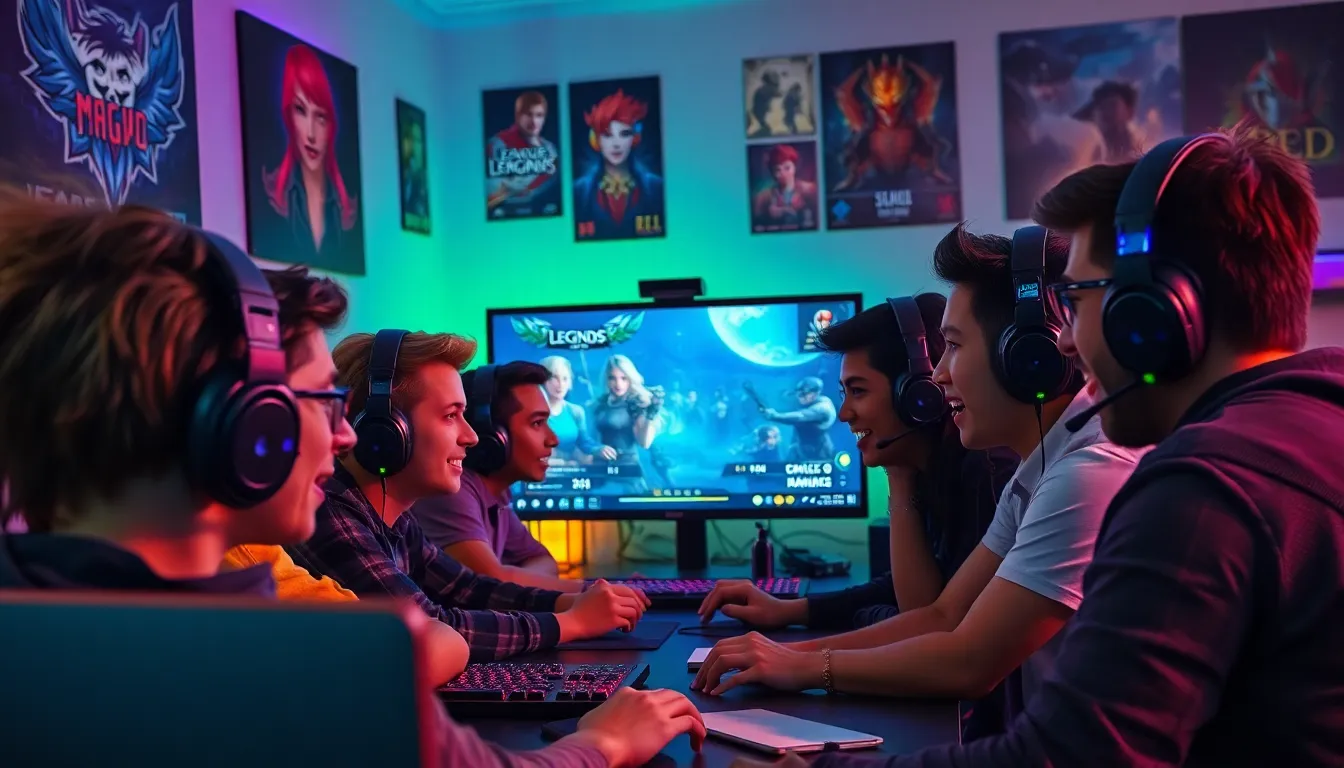Table of Contents
ToggleIn the vibrant world of esports, few titles have captured the hearts of millions quite like League of Legends. Launched in 2009, this multiplayer online battle arena game has evolved into a global phenomenon, drawing players and fans from every corner of the globe. With its rich lore, diverse champions, and strategic gameplay, League of Legends offers an experience that’s both thrilling and challenging.
Players engage in intense 5v5 matches, where teamwork and skill determine victory. As they navigate the Summoner’s Rift, they must adapt their strategies and champion choices to outsmart their opponents. The game’s competitive scene is thriving, with professional leagues and tournaments showcasing the best talent. Whether you’re a seasoned player or just curious about the hype, League of Legends continues to shape the landscape of gaming and esports.
Overview of League of Legends
League of Legends serves as a prominent multiplayer online battle arena (MOBA) game, officially launched in 2009. Developed by Riot Games, it allows players to assume the role of “champions” with unique abilities, engaging in strategic 5v5 matches on various maps.
The primary objective involves destroying the opposing team’s Nexus, a structure located within their base. Players select champions during the drafting phase, choosing from over 160 available characters, each of whom has distinct roles and abilities. These roles include assassin, tank, support, marksman, and mage, each contributing differently to team dynamics and strategies.
Game mechanics emphasize teamwork, communication, and strategy, with players collaborating to secure objectives such as turrets, dragons, and Baron Nashor. Players accumulate gold and experience throughout matches, enhancing their champions’ abilities during gameplay. Decision-making and adaptability play vital roles in achieving victory.
The professional scene showcases elite talent through various leagues and tournaments worldwide, such as the League of Legends Championship Series (LCS) and the League of Legends European Championship (LEC). These competitions highlight the game’s competitive nature and foster a growing esports ecosystem surrounding League of Legends.
The game’s lore adds depth to the experience, featuring rich storytelling intertwined with champion backstories and regional factions. This immersive world-building has captured a broad audience, enhancing player engagement both in and out of matches.
Gameplay Mechanics

Gameplay mechanics in League of Legends revolve around strategic decision-making, champion selection, and resource management. Players engage in fast-paced, team-oriented matches, where understanding these mechanics leads to victory.
Champions and Roles
Champions serve as unique avatars for players, each offering distinct abilities and playstyles. Players select champions based on defined roles, including:
- Assassin: Focuses on eliminating key targets quickly.
- Tank: Absorbs damage and protects teammates.
- Support: Aids allies with healing or utility spells.
- Marksman: Deals sustained damage from a distance.
- Mage: Employs powerful spells to control engagements.
Each role significantly impacts team dynamics. Successful teams often coordinate champion selection to maximize synergy and cover weaknesses.
Items and Builds
Items enhance champions’ abilities, providing unique effects and stats. Players construct their builds for optimal performance by selecting items that complement their champion’s strengths. Key aspects include:
- Starting Items: Chosen at the match’s onset; they set the stage for early-game strategy.
- Core Items: Essential for champion effectiveness; they enhance primary attributes.
- Situational Items: Adapted to counter opponents’ strategies or to bolster team needs.
Development of optimal item builds varies by champion role, game state, and opponent composition. Mastery of itemization and builds allows players to maximize their champions’ potential during matches.
Competitive Scene
League of Legends features a robust competitive scene, consisting of professional leagues and major tournaments that showcase elite player skills and strategic gameplay. This ecosystem not only fuels the esports industry but also captivates millions of fans worldwide.
Professional Leagues
Professional leagues form the foundation of the competitive League of Legends landscape. Leagues such as the League of Legends Championship Series (LCS) in North America and the League of Legends European Championship (LEC) serve as platforms for top-tier teams. Each league operates on a promotion and relegation system, allowing for dynamic competition and the emergence of new talent.
Teams engage in regular seasons where they compete in best-of-three or best-of-five matches. The standings determine playoff qualification, culminating in championship events that highlight the best teams each year. Regional leagues maintain strict regulations, ensuring fair play and competitive integrity, enforced by Riot Games.
Major Tournaments
Major tournaments amplify the excitement surrounding League of Legends’ competitive scene. The World Championship, held annually, represents the pinnacle of achievement, featuring the best teams from various regions battling for global supremacy.
Other notable tournaments include the Mid-Season Invitational (MSI) and regional events like the LCS Playoffs and LEC Finals. These tournaments attract worldwide viewership and generate substantial prize pools, incentivizing teams to excel. Players Leverage these high-stakes scenarios to demonstrate their skills, creating unforgettable moments that engage a global audience.
Community and Culture
League of Legends boasts a vibrant community and a rich culture, drawing players and fans together through shared experiences, creativity, and collaboration.
Player Community
Players create a diverse and interactive community, with enthusiasts connecting worldwide through forums, social media, and in-game chat. They share strategies, discuss champion specifics, and engage in friendly banter during matches. Community events, such as online tournaments and themed celebrations, promote camaraderie and a sense of belonging. Additionally, various fan-created platforms, like Reddit and Discord, facilitate communication and support among players, enabling them to share tips and experiences, and fostering lifelong friendships.
Content Creation
Content creation thrives within the League of Legends ecosystem, with streamers, YouTubers, and artists contributing to the game’s culture. Streamers on platforms like Twitch showcase gameplay, offering live commentary and engaging with viewers. YouTubers produce guides, gameplay highlights, and thematic videos to educate and entertain the audience. Artists create fan art, skins, and cosplay, paying tribute to beloved champions and expanding the game’s visual narrative. This creative output enriches the game experience, enhances community engagement, and elevates the overall culture surrounding League of Legends.
League of Legends continues to thrive as a cornerstone of the gaming and esports landscape. Its blend of strategic depth and community engagement keeps players invested and fosters a vibrant culture. The game’s competitive scene not only showcases top-tier talent but also inspires new players to join the ranks. With constant updates and evolving gameplay, League of Legends remains a dynamic experience that captivates millions worldwide. As it grows, the game’s influence on both casual and professional gaming will undoubtedly endure, solidifying its place in the hearts of fans for years to come.





